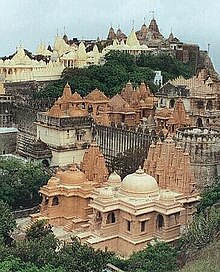Gujarati Jain

| Part of a series on |
| Jainism |
|---|
 |
Jainism has had a notable following in Gujarat.[1] According to the 2011 Census of India, around 0.959% of the population of Gujarat is Jain.[2] There are several old Jain temples that draw pilgrims from Jains around the world in places such as Palitana, Taranga, Sankheshwar, Idar.
History
Jains believe that their 22nd Tirthankara (propagators of Jain religion) Neminath attained Moksha/ Nirvana on Girnar in Gujarat. Many other holy Kalyanak places are present in Gujarat like Palitana(Shatrunjaya), Girnar, etc. Many other monks have also got attained Moksha in Gujarat; especially on the holy mountains of Girnar and Shatrunjaya. The Jain councils were held in Vallabhi c. 5th century CE.[3] Their canonical scriptures were written down during this council. King Vanaraja Chavda (c. 720-780 CE) of the Chavda dynasty was brought up by a Jain monk named Shilaguna Suri.
Jain temples are found in Gujarat from as early as the 6th and 7th centuries CE. It was patronized by the Chaulukyas and Chavadas.[4] Dhank Caves (3rd-7th century CE) in Rajkot district has Jain Tirthankara carvings. Northern Gujarat became a principle center of Jainism in the 13th century CE.[5]
The earliest known Old Gujarati text Bharat-Bahubali Ras, was written by a Jain monk Shalibhadra Suri.[6] Of the most important people in Gujarat's Jain history were the Acharya Hemachandra Suri and his pupil, the Chaulukya ruler Kumarapala.
Major Centers
Major ancient Jain centers include:
- Palitana
- Girnar
- Bhadreshwar
- Mahudi
- Shankheshwar
- Patan
- Taranga
- Radhanpur Jain Tirth
- Ahmedabad
- Surat
- Khambhat
Photo gallery
-
Samovsaran Mandir, Palitana Teerth
-
Vanki - Patri Jain Mandir, Kutch
See also
Notes
- ^ Glasenapp, Helmuth von (1999). Jainism. Motilal Banarsidass Publ. ISBN 9788120813762. Retrieved 21 January 2016.
- ^ "Census of India : C-1 Population By Religious Community". 27 August 2015. Archived from the original on 27 August 2015. Retrieved 2 May 2021.
- ^ Shah, Natubhai (2004). Jainism. Motilal Banarsidass Publishers. ISBN 9788120819382. Retrieved 21 January 2016.
- ^ Wink 1991, p. 355.
- ^ Prakash, Om (2005). Cultural History of India. New Age International. ISBN 9788122415872. Retrieved 21 January 2016.
- ^ Datta 1987, p. 454.
References
- Datta, Amaresh (1987), Encyclopaedia of Indian Literature: A-Devo, Sahitya Akademi, ISBN 9788126018031
- Glasenapp, Helmuth Von (1999). Jainism: An Indian Religion of Salvation. Delhi: Motilal Banarsidass. ISBN 81-208-1376-6.
- Wink, André (1991). Al-Hind the Making of the Indo-Islamic World. ISBN 9004102361. Retrieved 21 January 2016.










